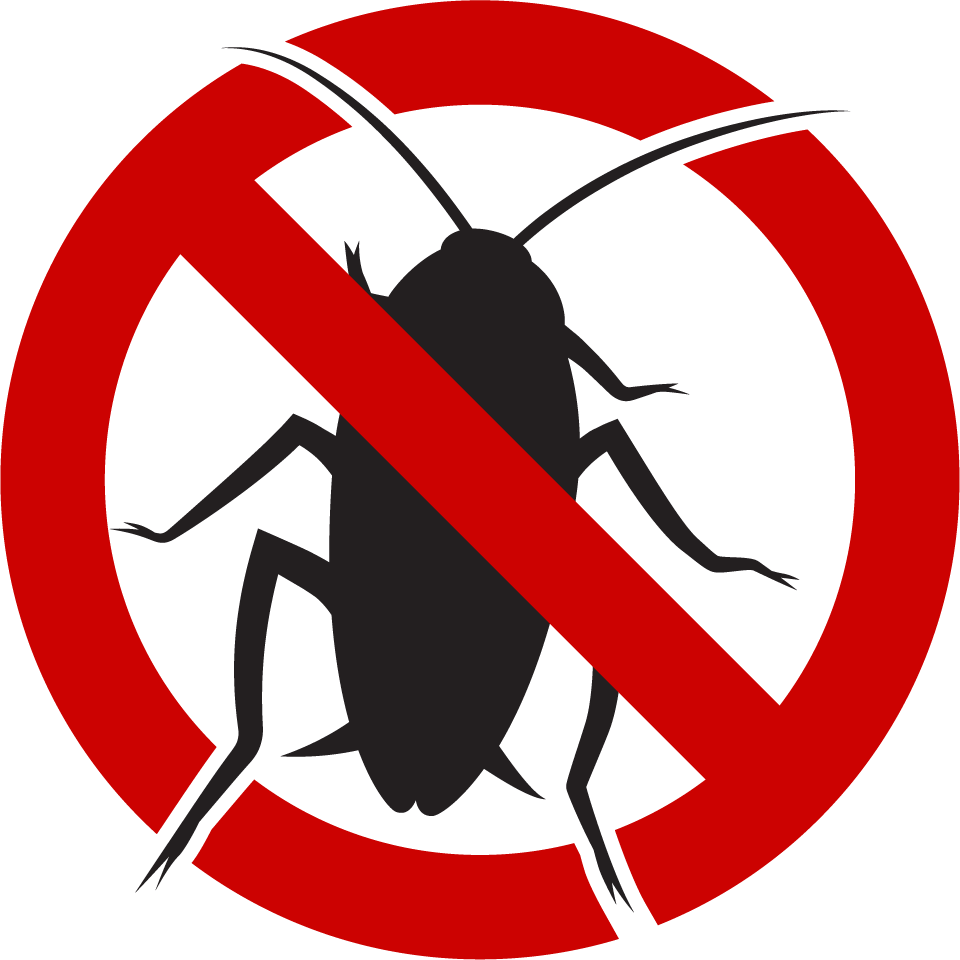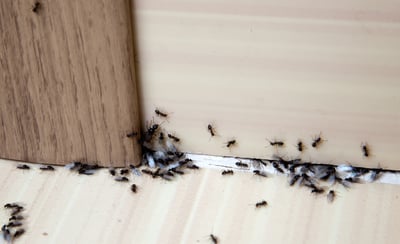Learning Center
Think Wikipedia, but for lawn care and pest control. You'll find lots of great information here!
![]()
Who knew lawn care could be so intricate and interesting?
This is a resource center for information about grass, weeds, and pests. Curious about a specific weed you have in your lawn? Check it out below!
Here is a quick set of some words to know before you get to reading–
Annual Weeds –
This type of weed completes a full life cycle in a single year. They can begin their life cycle in either spring or autumn.
Biennial Weeds –
This type of weed takes 2 years to complete a full life cycle.
Broadleaf Weeds –
This type of weed is typically characterized by having wide leaves that grow out from the plant's stem. They grow from clusters, and they typically have fibrous root systems. They are notoriously difficult to eliminate from a lawn.
Dormancy –
This word is used to describe a plant that shuts down in certain conditions, usually temperature based. Although the plant will often turn brown, it is not dying during dormancy, but it is simply conserving its resources to get through a weather period where it does not thrive in.
Grass –
A green, low, non-woody plant. Often used for ornamental purposes in lawns.
Grassy Weeds –
This type of weed is actually a type of grass. It is a different type of grass that makes lawns look less uniform, making them undesirable. They can be harder to identify than other weeds because they blend in more with your lawn, but can still stand out.
Perennial Weeds –
This type of weed lives more than two years. It will last longer than annual or biennial plants, recurring continually. They return each season from their own roots, meaning they produce offspring from root or seeds, die out, then return.
Pest –
Any undesirable organism on your property is considered a pest.
Sedge Weeds –
This type of weed is characterized by have leaves that are 3-ranked. They are often grass-like in appearance and grow in clusters.
Weeds –
Any undesirable plant in your lawn is considered a weed. In other words, a plant out of place, growing where you do not want it to grow, is a weed!
Bermuda
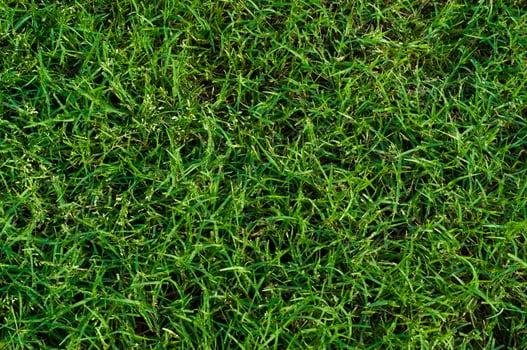
Overview–
Bermuda is a warm-season grass that is best known for its ability to sustain itself in times of drought and extreme heat. It is native to tropical regions, and can be invasive in nature. While it enjoys warm temperatures, it is not fond of cool temperatures and will enter a period of dormancy in the wintertime, where it turns brown and conserves its energy.
Advantages–
- Thrives in extreme heat
- Tolerant of drought and low water
- Springs back quickly from heavy foot traffic
- Bright green from late spring through summer and usually early autumn
- Returns every year from dormancy as temperatures warm from winter weather
Disadvantages–
- Low tolerance of cool temperatures, entering dormancy when ground temperatures reach lower than about 55ºF
- Requires full sunlight
- Requires good drainage so as not to soak the grass
- Turns brown in cooler temperatures to conserve its energy and survive
- Can be invasive if you have another type of grass
The Bottom Line–
For areas where the climate is warm year-round, Bermuda is perfect. Its lack of tolerance for cool temperatures and shade prevent it from being the most widespread used grass, but overall it thrives in southern regions of the United States due to its ability to withstand foot traffic well.
Tall Fescue
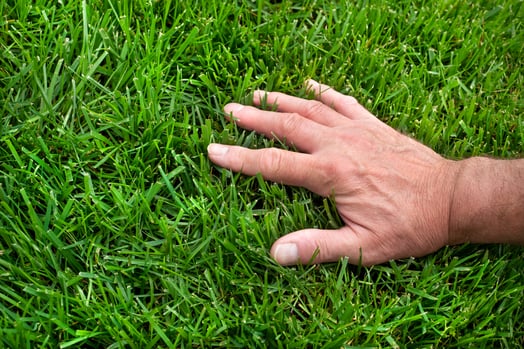
Overview–
Tall Fescue is a cool-season grass that is known for its dark green color. It has a minor heat tolerance, which improves its durability, even during the hot summer. It is native to Europe.
Advantages–
- Stays green no matter the temperature when it is healthy
- Thrives in autumn, winter, and spring
- Great for cooler climates that don't have extreme heat
- Tolerant of drought and low water (when in cooler temperatures)
- Grows better in shaded areas than most grasses
- Higher heat tolerance than most cool-season grasses
- Higher cold tolerance than most warm-season grasses
- Seeds germinate easily
- Relatively low maintenance
- Good with foot traffic
Disadvantages–
- Coarser texture than many grasses
- Heat can exhaust it very quickly
- Requires lots of water in hot summer temperatures
- Becomes patchy at the end of summers due to lawn damage
- Damages must be repaired with re-seeding and growing new grass
The Bottom Line–
Not only is Tall Fescue great for cool temperature climates, but it is excellent for areas that experience hot summers and cool winters. It's a happy medium that stays green in all temperature ranges when properly cared for, even though it is likely to become patchy after a long hot summer.
St. Augustine
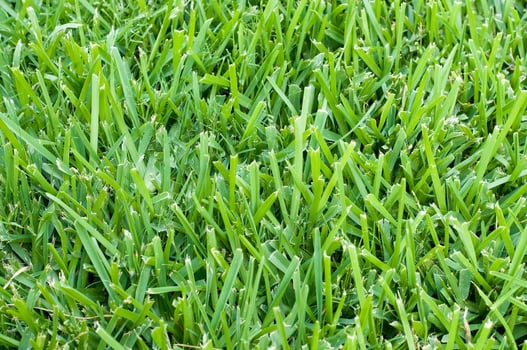
Overview–
St. Augustine is a warm-season grass that is dark green with wide, flat blades. It is native to tropical regions, and grows in thick.
Advantages–
- Thrives in warm temperatures
- Tolerates drought and low water, though not as well as Bermuda or Zoysia
- Grows in thick, making it difficult for weeds to poke through
- Can tolerate some shade, better tolerance than some warm-season grasses
Disadvantages–
- Requires higher maintenance
- Goes dormant and turns brown with ground temperatures below 55ºF
- Less tolerant of drought and low water
- Least wear/ foot traffic tolerance compared to most warm-season grasses
- Coarser texture than most grasses
The Bottom Line–
St. Augustine grass will grow best in areas that don't really have a winter. In warm temperatures, it can tolerate some shade. But it is not a great option for heavy foot traffic, and be aware of the fact that you'll need more maintenance than other warm-season grasses.
Zoysia
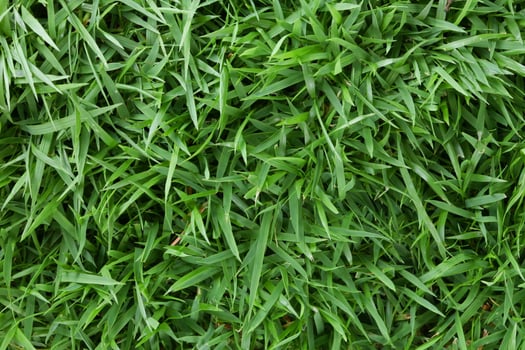
Overview–
Zoysia is a warm-season grass that is resistant and dense. It is native to Asia and enjoys sunlight, but can still do well in mildly-shaded areas.
Advantages–
- Thrives in warm temperatures
- Better cool temperature tolerance than most warm-season grasses
- Tolerates drought and low water
- Remains fairly strong even after heavy foot traffic
- Returns each year during late spring as temperatures warm up
- Requires relatively little maintenance
- Grows in thick, making it difficult for weeds to poke through
Disadvantages–
- Turns brown when winter dormancy comes
- Can be difficult to seed and grow initially
- Can be invasive in nature
- Does not handle shade well
The Bottom Line–
Because Zoysia grass stays green much longer than Bermuda, Zoysia can be a good option in areas that have both cold winters and hot summers. It can be difficult to introduce, but has many advantages that make it a great grass for these areas.
Bittercress
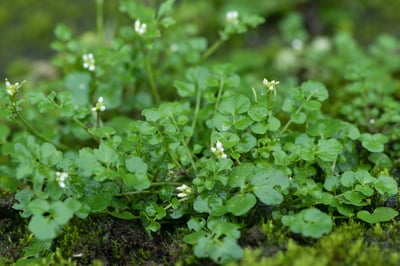
Type: Broadleaf
Frequency: Annual
Size: Height of about 3-9 inches
Appearance: Unique foliage that makes it easy to identify. Leaflets have a club shape. As leaves mature, they are generally compounded.
Where it grows: Anywhere where there is moist soil, especially in cooler temperatures.
Control: Apply a pre-emergent herbicide before the weed seeds germinate. Also, keeping a healthy grass keeps the weeds from germinating. Warmer temperatures also greatly reduce this weed.
Key Identification:
- Opposite leaves, largest leaves at the base of the plant
- Tiny white flowers at the ends of stems
- Club-like shape to the leaves
Other Notes: Bittercress prefers cool, moist soil in the early spring. Deep root systems make them difficult to pull out manually. It can spread extremely quickly, but will slow in spread in warmer temperatures.
Chickweed
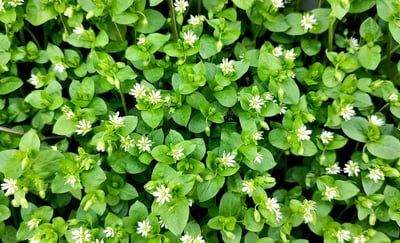
Type: Broadleaf
Frequency: Annual
Size: About 6 inches tall, 12 inches wide
Appearance: Lush green mats studded with small, star-shaped flowers
Where it grows: Found along the east coast of the United States. Lawn, garden, and landscape areas with rich, moist soil in sun or shade
Control: Mulch to prevent in gardens or use a pre-emergent herbicide in early spring. Can also be pulled out by the roots by hand.
Key Identification:
- Grows low to the ground
- Hairy stems
- Small, white flowers
- Elongated petals
- Oval-shaped leaves with pointy tips
Other Notes: Each plant can produce up to 15,000 seeds. Chickweed can be used for many medicinal purposes. It is also commonly known as starweed, satin flower, or mouse-ear.
Corn Speedwell
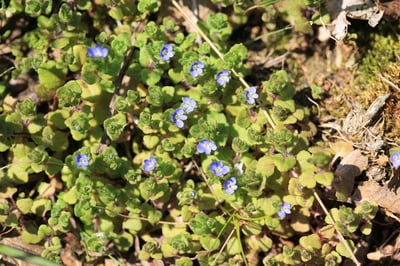
Type: Plantain broadleaf
Frequency: Winter annual
Size: 3.5-16 inches tall
Appearance: Tiny blue flowers with a white throat, and always 4 petals
Where it grows: Requires lots of light to grow and will remain dormant without light.
Control: The most effective approach is to apply pre-emergent herbicides in the fall to prevent seeds from sprouting. It will not re-grow from the roots, so hand weeding is effective as long as all of the leaves and stems are removed.
Key Identification:
- Small blue and purple flowers with a white throat
- Always 4 petals per flower
- Heart-shaped seed pods
- Small rounded leaves no more than 1/2 inch in diameter with notched edges
- Hairy stems and leaves
Other Notes: Speedwell has a fibrous root system.
Crabgrass
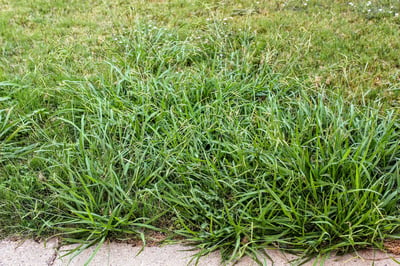
Type: Grassy weed
Frequency: Annual or perennial
Size: Large patches, usually around 12 inches
Appearance: Grows in patches with broad leaf blades that resemble grasses. Grows very low to the ground.
Where it grows: Areas with hot summers and lots of rainfall allow crabgrass to run rampant. It also often pops up in sidewalk and driveway cracks.
Control: You will likely need both pre and post-emergent weed control– pre-emergents to stop crabgrass from germinating, and post-emergents to kill the crabgrass that pops up. Systemic post-emergents are good because they will not kill your grass, just the crabgrass, but they will take longer. It grows too close to the ground to run over with a lawn mower.
Key Identification:
- Patches of broad leaf grass blade
- Appears to grow outward from a center
- Long stems that split into grass blades
- Has many "legs" (stems)
Other Notes: Crabgrass can drop up to 150,000 seeds in its lifetime, so it is essential to stop crabgrass from growing in the first place. Before the summer months and during the warm season, make sure to get a pre-emergent weed control on your lawn to stop weeds from growing in the first place.
Dallisgrass
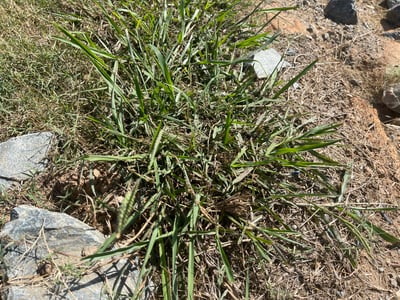
Type: Grassy weed
Frequency: Perennial
Size: Large patches, usually around 12 inches
Appearance: Wide-blade, coarse-textured grass that grows in large clumps
Where it grows: Grows well in 80-90ºF weather. Often seen in wet areas.
Control: You will likely need both pre and post-emergent weed control– pre-emergents to stop crabgrass from germinating, and post-emergents to kill the dallisgrass that pops up. Systemic post-emergents are good because they will not kill your grass, just the dallisgrass.
Key Identification:
- Purple color often seen at stem base
- Grows outward from a center
- Very wide grass leaves
- Very coarse texture
- Has flowering stalk that contains two rows of flat, egg-shaped seeds
Other Notes: Dallisgrass can tolerate both clay and sandy soil types, does well even in drought conditions, and does not go dormant during the winter. Grass blades can grow up to 10 inches long when left alone.
Dandelions
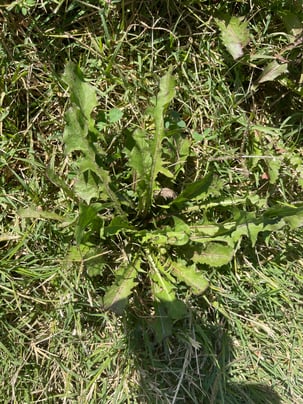
Type: Broadleaf
Frequency: Perennial
Size: 4-8 inches tall
Appearance: Jagged with deep lobes. Yellow flowers and white flowers that create a 360 degree sphere shape
Where it grows: Grow best in areas that are sunny and moist
Control: Post-emergent herbicides are growth regulators that mimic hormones.
Key Identification:
- Stems are hollow with white juice
- Small yellow flowers
- Unique, fluffy, white flowers that look spherical around a brownish center. These are part of the seedhead.
Other Notes: Seeds vary from about 50-175 seeds per head, about 2,000 seeds per plant. They are light, which makes them good to float in the wind. Dandelion flowers have antioxidant properties. It is also said that if you make a wish and blow all the florets off of the white flowers, it is good luck and the wish will come true!
Henbit
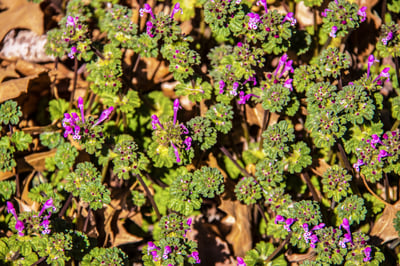
Type: Broadleaf
Frequency: Winter annual
Size: Up to about 12 inches tall and wide
Appearance: Low, creeping plant with scallop-edge leaves and purple flowers
Where it grows: Lawn, landscape, and garden areas. Grows well in sun or shade
Control: Mulch to prevent it in gardens. Use pre-emergent herbicide in spring, and post-emergent broadleaf herbicide to kill the henbit that has already germinated. Pulling plants by hand is also effective.
Key Identification:
- Heart-shaped leaves
- Scalloped edges on leaves
- Leaves grow along the entire length of the stem
- Small purple flowers
Other Notes: Often confused with the purple dead nettle. Both henbit and purple dead nettle are edible. It is named henbit because chickens enjoy eating it. Thrives as temperatures warm in the spring, but dies in the hot summer.
Large Hop Clover
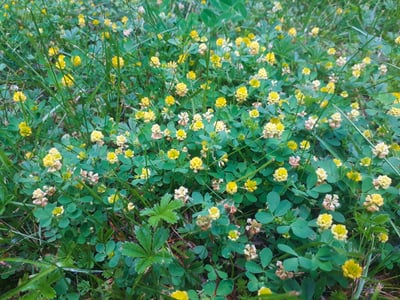
Type: Broadleaf
Frequency: Winter Annual
Size: About 12-14 inches tall
Appearance: Leave alternate and consist of three leaflets
Where it grows: Lawns, gardens, unmowed areas, often on hillsides or pastures
Control: Mulch to prevent it in gardens. Pre-emergent weed control in spring. Post-emergent broadleaf weed control if it has already appeared. Pulling plants by hand is also effective, as long as it has not flowered yet. Pulling flowered large hop clover can result in further spreading of seeds.
Key Identification:
- Stems feel a bit woody, are hairy, and are green or reddish in color
- Hairless leaves
- Stipules are lance-shaped
- Leaves are elliptical in shape and are found in sets of 3, growing alternatively on the stem
- Bright yellow flowers
Other Notes: Commonly called field clover.
Nutsedge
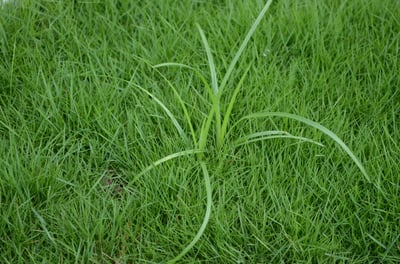
Type: Grassy weed
Frequency: Perennial
Size: Tall lengths that extend over grass blades
Appearance: Long, grass-like blades that extend up in small patches
Where it grows: Just about everywhere!
Control: Nutsedge can be difficult to get rid of– it is aggressive and persistent. Pulling this weed manually will not do enough. You must dig in the ground about 10 inches deep and 10 inches past the diameter of the above ground portion of the plant to rid of the tubers. Post-emergent weed control is recommended and effective against nutsedge, but it will take a while to kill it off completely without causing damage to desirable grass and plants.
Key Identification:
- Grass-like blades that are broad
- Long leaf blades
- Blades are creased in the center
- Stems are V-shaped
Other Notes: Also commonly referred to as nutgrass. Be sure to clean any tools thoroughly that you used to clear nutsedge– you can end up spreading seed unintentionally! The tubes and rhizome pieces are tough to get rid of completely, and they can cause nutsedge to return.
Oxalis
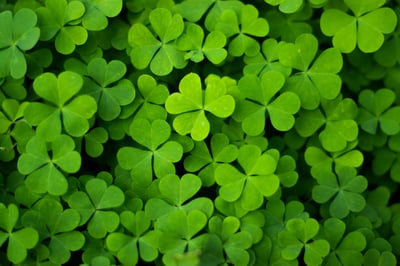
Type: Broadleaf
Frequency: Annual or perennial
Size: Low to the ground, but large patches can occur
Appearance: Light green leaves that look like cover. Yellow flowers in summer and fall
Where it grows: Sunny or shady landscape, lawns, or garden areas
Control: Pulling oxalis is not effective, and can in fact cause further spreading. Pulling leaves behind rhizome, which can just grow new clusters. You will want to apply pre and post-emergent weed control to keep this weed under control.
Key Identification:
- Looks similar to clover
- Grows low to the ground
- Cup-shaped yellow flowers with 5 petals
- Trifoliate, heart-shaped leaves
- Stems are green to pink, weak, and branched at the base
- Flowers occur in clusters, and color can be white, pink, red, or yellow
Other Notes: Often mistaken for clover. Oxalis can be very difficult to get rid of, and it can be a long process. It is common to be found in your lawn, but an excessive amount can indicate that your lawn or soil have issues. Be sure to not mow too short and keep your lawn think and healthy to beat out oxalis. The fruit it bears is edible for humans.
Pigweed
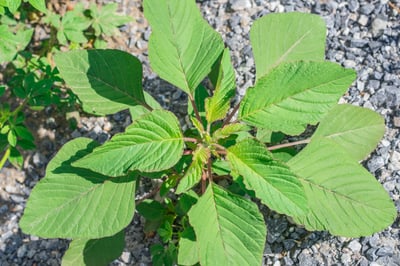
Type: Broadleaf
Frequency: Summer annual
Size: Usually found along the ground, growing a max of 3 feet, but can grow up to 10 feet if left completely untouched.
Appearance: Upright-growing plant that extends several inches above the ground. Lower leaves are egg-shaped. Leaves alternate each other on the stems. If it flowers, they form spiky bunches in the center of the leaves.
Where it grows: Thrives in open, sunny places
Control: You will want to apply pre and post-emergent weed control to keep this weed under control.
Key Identification:
- Mirrored, alternating leaves
- Egg-shaped leaves
- Prominent veins in leaves
- Hairy stems in mature plants
- Plant grows upright
- Reddish roots and stems
Other Notes: There are many different species of pigweed, and it can be very difficult to control. It grows in just about any spot where the soil is disturbed and there is sunlight. Can be toxic to consume, especially just before flowering.
Plantain Broad Leaf
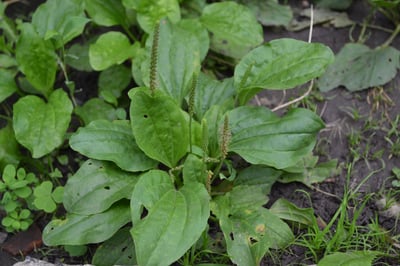
Type: Broadleaf
Frequency: Perennial
Size: 6-12 inches in diameter, about 4 inches tall
Appearance: Low-growing, green plant with broad oval-shaped leaves
Where it grows: Sun or shade, in almost any soil. Highly adaptable
Control: The best way to prevent plantain broad leaf in your lawn is to keep your soil aerated and healthy. Aeration and regular fertilization are key to keeping this weed out of your lawn.
Key Identification:
- Broad leaves
- Short-stemmed leaves that are oval-shaped and ribbed
- Leaves hugs the ground
- Low growing rosette habit
- Flowers are small and greenish-brown in color
Other Notes: Plantain broad leaf is not closely related to the fruit known as plantain. It can tolerate low mowing, and also can contaminate mowers so be sure to clean yours if you mow over it! It has the ability to survive a range of environments, which can make it tricky to get rid of once you have it. It is also edible.
Poa Annua
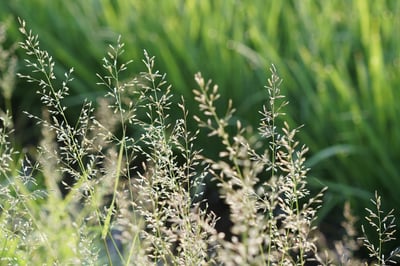
Type: Grassy weed
Frequency: Annual
Size: Small clumps yet can be widespread
Appearance: Grass-like, with small white flowers
Where it grows: Anywhere that grass grows
Control: Because poa annua is a grassy weed, it is difficult to control once it has emerged. Apply pre-emergent herbicide in early fall and again in early spring to keep it from germinating and sprouting in the first place. You'll have to treat your lawn this way for many seasons in order to completely rid of this weed.
Key Identification:
- Grass-like
- Opens out into small white flower pieces
- Blades are soft and drooping
- Leaves are bright green, short, and blunt
Other Notes: Very similar to Kentucky Bluegrass. It is resilient, and seeds can survive many seasons without germinating before finally germinating later. That is part of what makes it so difficult to control and get rid of– you need constant pre-emergent control throughout the years.
Top Turf Poa Annua Program: Because it is such a tough weed to get rid of, Top Turf actually offers a specific Poa Annua program! Please contact your local branch if you are interested in this service.
Poa Trivialis
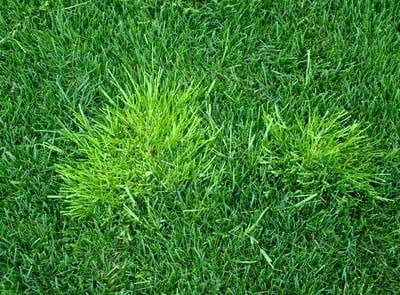
Type: Grassy
Frequency: Perennial
Size: The stem grows from 6 to 10 inches tall
Appearance: Grass-like, seems to stand above the rest of the lawn
Where it grows: Anywhere that grass grows, moist lawns, especially in cooler climates
Control: Because it is a grassy weed, it is difficult to control once it has emerged. Apply pre-emergent herbicide in early fall and again in early spring to keep it from germinating and sprouting in the first place. You'll have to treat your lawn this way for many seasons in order to completely rid of this weed.
Key Identification:
- Grass-like
- Pops up over the top of Fescue grass
- Bright green in color, as compared to the darker green of Tall Fescue lawns
Other Notes: Commonly referred to as rough bluegrass. It is resilient, and seeds can survive many seasons without germinating before finally germinating later. Enjoys colder weather and goes dormant in the summertime, leaving bare spots in your lawn in the summer.
Prickly Lettuce
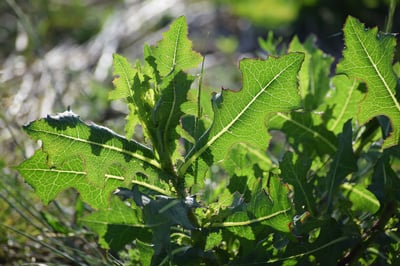
Type: Plant weed
Frequency: Annual
Size: about 12 inches tall
Appearance: Alternating leaves that clasp the stem.
Where it grows: Prefers dry conditions, but can be found in moist areas as well
Control: Use a pre-emergent herbicide and of course– pull wild lettuce when the soil is damp and dig down to get all of the tap roots.
Key Identification:
- Leaves are deeply notched with a spiny margin
- Gray-green in color
- Waxy appearance
- Blossoms are yellow in color and about 1/3 inch across
- Contains a milky white latex in the stem
Other Notes: A single plant can produce anywhere from 35 to 2,300 flowers, each containing around 20 seeds and adding up to a total of 700 to 46,000 seeds per plant!
Red Stem Filaree
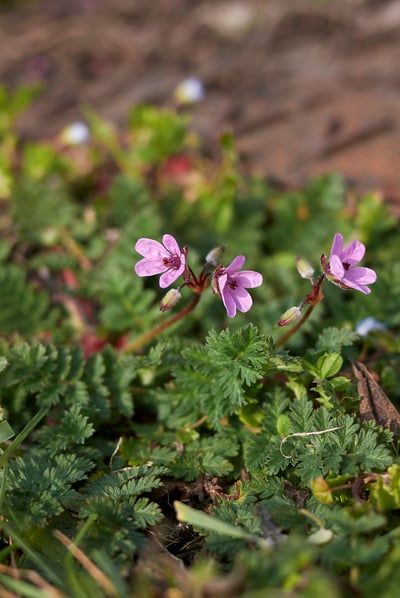
Type: Flowering plant
Frequency: Annual
Size: 4-6 inches in height
Appearance: Deeply lobed leaves that somewhat resemble a fern. It gets its name from the reddish stems
Where it grows: Commonly seen on roadsides, fields, and can be found in lawns
Control: Mulch to prevent it from growing in gardens. Use pre and post-emergent weed control. Pull plants by hand.
Key Identification:
- Deeply lobed leaves
- Hairy stems that are reddish in color
- Sticky
- Small, bright pink flowers with five petals each
Other Notes: Keep your lawn healthy and this one shouldn't be a problem for you! Also known as redstem stork's bill, common stork's-bill, or pinweed.
Small Hop Clover
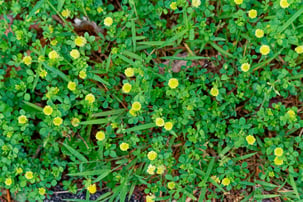
Type: Trifoliate broadleaf
Frequency: Winter annual
Size: 12-14 inches high
Appearance: Branched stems spread in a low creeping manner
Where it grows: Common in the entire continental United States
Control: Mulch will help prevent it in gardens, along with pre and post emergent weed control. You can pull weeds by hand as well with effectiveness, especially if it isn't widespread.
Key Identification:
- Stems are red and hairy
- Leaves alternate sides
- Leaves consist of three leaflets with the center leaf on its own petiole
- Stems feel a bit woody
- Clusters of flowers
Other Notes: Don't give clover a chance to spread. Get rid of small clumps as soon as you notice them by gently loosening the soil around the base with a spade or your fingers, then pluck the clover up. Be sure you get all of the roots or you could be planting more weeds unintentionally!
Sow Thistle
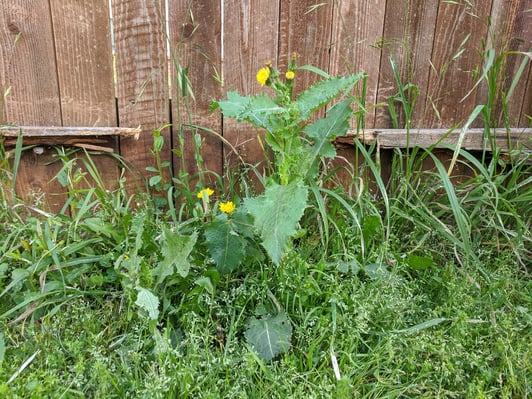
Type: Broadleaf
Frequency: Annual or perennial
Size: 12-36 inches high
Appearance: Soft green, deeply-lobed leaves and yellow flowers
Where it grows: Gardens, roadsides, and lawns
Control: Improving your soil's fertility will weaken the thistle and help desired plants grow better. Most desirable plants will compete and win against thistle with healthy soil. It can also be killed by a post-emergent weed control.
Key Identification:
- Deeply-lobed leaves
- Leaves are spear-like, with sharp barbs
- Yellow flowers
Other Notes: The most common use of thistle is food for rabbits. They love it!
White Clover
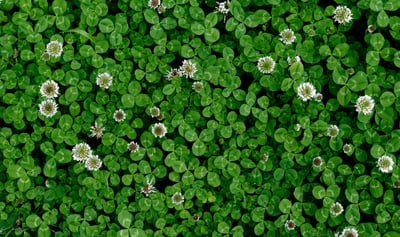
Type: Trifoliate broadleaf
Frequency: Perennial
Size: About 6-12 inches tall
Appearance: The leaves on clover grow in sets of 3 leaflets, and it grows in patches low to the ground
Where it grows: Mainly found in lawns, especially in sparse lawns where the competition from grass is weak.
Control: Keep your lawn full, healthy, and fertilized. It will overtake any clover easily. Clover also grows in areas of low nitrogen, and grass will make the soil less suitable for clover.
Key Identification:
- Each stem produces 3 leaflets
- Teardrop or heart shaped leaves
- Flowers are white with a brownish-green center
Other Notes: In flower beds, clover can be kept at bay by using a thick layer of mulch to keep the seeds from germinating. It is also said that if you find a clover stem with 4 leaves, it's good luck!
Wild Garlic
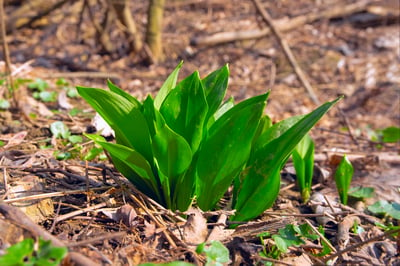
Type: Grassy
Frequency: Perennial
Size: 8-12 inches high
Appearance: Slender, bright green leaves that rise above the turf
Where it grows: Found in many gardens and lawns
Control: Pre and post-emergent weed controls. You can also dig the clump out of the ground with a spade or trowel. Throw the entire clump away and spray an on-contact weed killer in the hole. It can have multiple bulbs that sprout at different times of year, which makes it difficult to get rid of sometimes. Keep at it!
Key Identification:
- Slender, bright green leaves
- Leaves will rise above the turf
- Leaves are hollow and have a waxy appearance
- You can smell it
Other Notes: Wild garlic is often confused with wild onion, but it has hollow, waxy leaves that contrast with the flat leaves of wild onion. Mowing will also slow the spread of this weed.
While this garlic is technically edible, please be extremely careful if you decide to eat it, especially if you have applied any chemicals to your lawn or flower bed.
Wild Onion
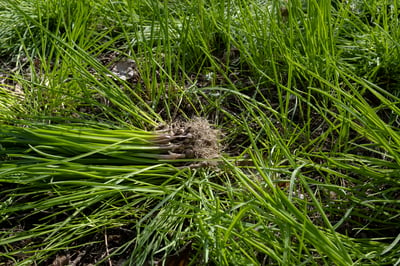
Type: Grassy
Frequency: Perennial
Size: 8-12 inches high
Appearance: Slender, bright green leaves that rise above the turf
Where it grows: Found in many gardens and lawns, in sun or shade
Control: Pre and post-emergent weed controls, as well as keeping your lawn healthy and fertilized to not allow these weeds to poke through. Mowing also slows the spread of this weed. You can also dig the clump out of the ground with a spade or trowel. Throw the entire clump away and spray an on-contact weed killer in the hole. It can have multiple bulbs that sprout at different times of year, which makes it difficult to get rid of sometimes. Keep at it!
Key Identification:
- Slender, bright green leaves
- Leaves will rise above the turf
- Leaves are flat in appearance
- You can smell it
Other Notes: Wild onion is often confused with wild garlic, but it has flat leaves that contrast with the hollow, waxy leaves of wild onion. They also look similar to the garden variety of onion but are much thinner and do not grow as tall.
While these onions are technically edible, please be extremely careful if you decide to eat them, especially if you have applied any chemicals to your lawn or flower bed.
Centipedes
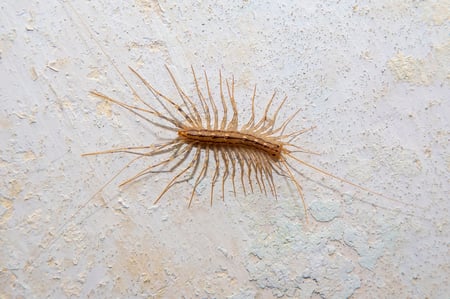
Type: Arthropod
Size: 1 to 1.4 inches
Appearance:
- Usually yellowish gray in color
- Up to 15 pairs of legs
- Long legs
Other Notes: Centipedes are carnivorous. They will kill and eat insects, spiders, and even other centipedes. If you have any pests in your home, theses are actually the best to have because they will keep the populations of other bugs down for you. They are also extremely speedy critters.
Cockroaches
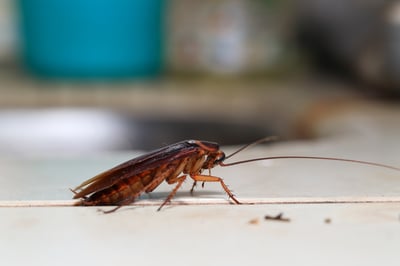
Type: Insect
Size: Most are small, about 1 inch in length
Appearance:
- 3 pairs of legs
- Small head
- Broad, flattened body
- Usually reddish-brown to dark brown in color
- Two long antenna on their heads
Other Notes: Cockroaches are among some of the oldest insects, with ancestors dating back to up to 350 million years ago. They are true survivalists that can live in almost any climate, though they do prefer warmer temperatures. They can survive up to a month without food and a week without water. Some species are even social and work together to help each other.
Earwigs
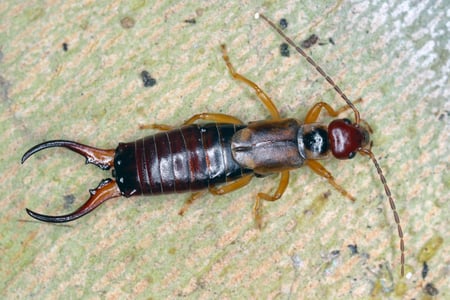
Type: Insect
Size: Most are about 1/3 inch to 2 inches in length
Appearance:
- 3 pairs of legs
- Small head
- Flattened body
- Usually grayish-brown in color
- Two long antenna on their heads
- Two pincers on their face
- They have small wings, but are rarely seen in flight
Other Notes: Earwigs have small bodies that allow them to fit into tiny crevices and cracks. This is where they hide during the day. At night, they come out and like to eat flowers, plants, and other insects.
Fire Ants
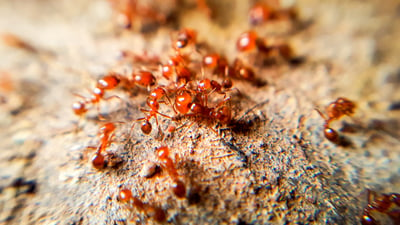
Type: Insect
Size: 2 to 6 millimeters in length
Appearance:
- 3 pairs of legs
- Sectioned body
- Red or orange in color
- A pair of antenna
- Two pincers on their face
Other Notes: Fire ants inject venom when they bite. They are known for building large mounds to live in. They are an invasive species. They feed mostly on young plants and seeds.
Fleas
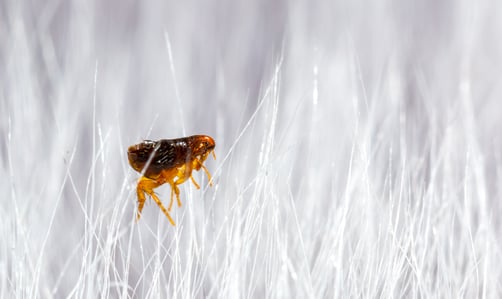
Type: Insect
Size: about 3 millimeters in length
Appearance:
- 3 pairs of legs
- Slender bodies to allow them to maneuver through fur and feathers of their hosts
- Dark brown, almost black in color
- Mouth optimal for piercing skin and sucking blood
- Legs have claws at the end to grip onto their host
Other Notes: Fleas are flightless and feed on the blood of most mammals and birds. They are an external parasite and are often known for spreading disease. They can jump up to 50 times their body length.
Mice
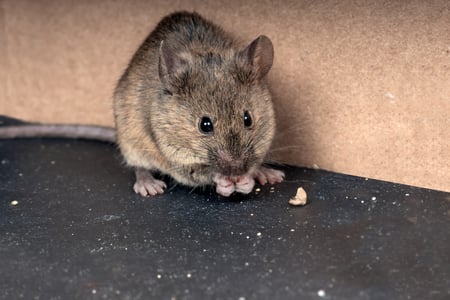
Type: Mammal, rodent
Size: about 3-4 inches in length
Appearance:
- Pointed snout
- Large, rounded ears
- Gray, brown, white, or black in color
- Fur on body
- Long, scaly, almost hairless tail that is about as long as their body length
- Small claws on the ends of their feet to climb with
- Sharp front teeth
Other Notes: Mice are excellent runners, jumpers, climbers, and swimmers. Their tails are used for balance as well as body temperature regulation. They feed mainly on plants, but they are omnivorous.
Mosquitoes
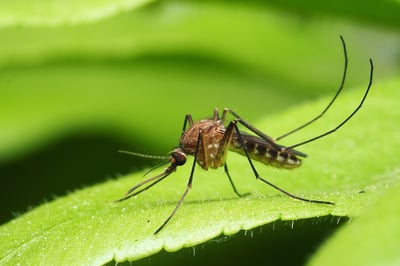
Type: Insect
Size: about 3 to 6 millimeters in length
Appearance:
- Long nose for sucking blood
- 3 pairs of legs
- 1 pair of wings
- Dark brown, almost black in color
Other Notes: Mosquitoes are flying creatures who bite mammals and suck their blood. They are responsible for carrying and spreading many diseases including malaria, Zika virus, and more.
Rats
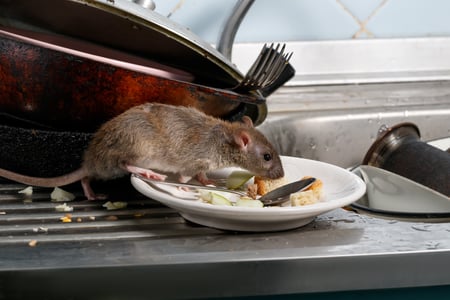
Type: Mammal, rodent
Size: about 3-4 inches in length
Appearance:
- Pointed snout
- Large, rounded ears
- Gray, brown, white, or black in color
- Fur on body
- Long, scaly, almost hairless tail that is about as long as their body length
- Small claws on the ends of their feet to climb with
- Sharp front teeth
Other Notes: Rats are excellent runners, jumpers, climbers, and swimmers. Their tails are used for balance as well as body temperature regulation. They feed mainly on plants, but they are omnivorous. They are distinguished from mice mainly by size; rats are larger than mice.
Scorpions
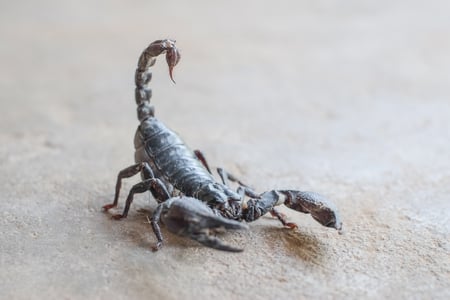
Type: Scorpion
Size: Ranges depending on the species
Appearance:
- 8 legs
- 1 pair of pincer claws
- Narrow, segmented tail
- Usually brown in color
- Stinger on the end of the tail
- Tail curls upward above the body
- Hard exoskeleton
Other Notes: Some species of scorpions are venomous, but most are not. Their stings are very powerful and can be used for either killing prey or for defense from predators.
Silverfish
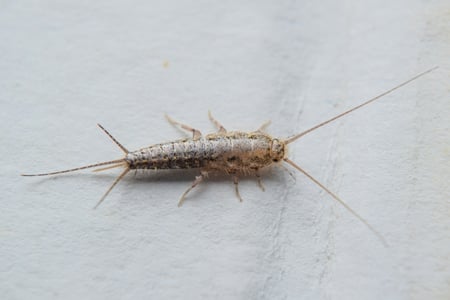
Type: Insect
Size: 1/2 to 1 inch in length
Appearance:
- 6 legs
- Silver in color
- Slightly shiny
- Resembles a fish when it moves
- Long antenna
- No wings
Other Notes: Silverfish are nocturnal creatures. They are agile and try to avoid light. They can cause damage when they are feeding. They enjoy eating carpet, clothing, coffee, hair, and more.
Spiders
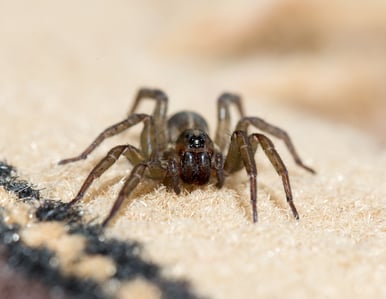
Type: Arachnid, arthropod
Size: Ranges depending on the species
Appearance:
- 8 legs
- Segmented body
- Fangs that can inject venom (in most species)
- Color ranges depending on species, but most are either black or brown
- Spinnerets to produce silk for web
Other Notes: Spiders build webs with their silk they produce. They trap prey in their webs, they eat mostly insects and other spiders. Some species are venomous, but not all.
Termites
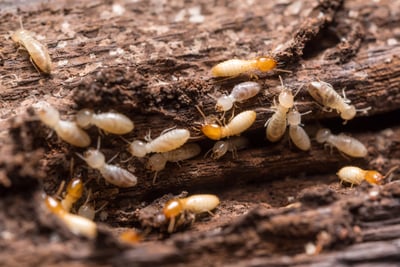
Type: Insect
Size: About 4 to 15 millimeters in length
Appearance:
- 6 legs
- 3-segmented body
- 2 pairs of wings
- White to light orange in color
Other Notes: Termites work in a caste system society with workers and queens. Workers are in charge of creating habitats and getting food for the rest of the colony.
Ticks
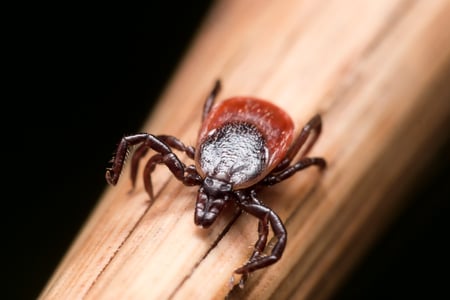
Type: Arachnid
Size: About 3 to 5 millimeters in length
Appearance:
- 8 legs
- Small and round
- They grow rounder after feeding
- Usually brown in color
Other Notes: Ticks are known for spreading disease. They feed on the blood of almost any animal, including mammals, birds, reptiles, and amphibians. They are found often in warm, humid climates.


